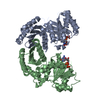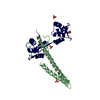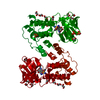[English] 日本語
 Yorodumi
Yorodumi- PDB-1g4y: 1.60 A CRYSTAL STRUCTURE OF THE GATING DOMAIN FROM SMALL CONDUCTA... -
+ Open data
Open data
- Basic information
Basic information
| Entry | Database: PDB / ID: 1g4y | ||||||
|---|---|---|---|---|---|---|---|
| Title | 1.60 A CRYSTAL STRUCTURE OF THE GATING DOMAIN FROM SMALL CONDUCTANCE POTASSIUM CHANNEL COMPLEXED WITH CALCIUM-CALMODULIN | ||||||
 Components Components |
| ||||||
 Keywords Keywords | SIGNALING PROTEIN / small-conductance calcium-activated potassium channel / calmodulin / calmodulin binding domain (CaMBD) / channel gating | ||||||
| Function / homology |  Function and homology information Function and homology informationCa2+ activated K+ channels / regulation of store-operated calcium channel activity / : / : / small conductance calcium-activated potassium channel activity / membrane repolarization during atrial cardiac muscle cell action potential / regulation of response to tumor cell / positive regulation of autophagic cell death / DAPK1-calmodulin complex / calcium-activated potassium channel activity ...Ca2+ activated K+ channels / regulation of store-operated calcium channel activity / : / : / small conductance calcium-activated potassium channel activity / membrane repolarization during atrial cardiac muscle cell action potential / regulation of response to tumor cell / positive regulation of autophagic cell death / DAPK1-calmodulin complex / calcium-activated potassium channel activity / : / : / : / : / : / positive regulation of potassium ion transport / inward rectifier potassium channel activity / establishment of protein localization to mitochondrial membrane / type 3 metabotropic glutamate receptor binding / establishment of protein localization to membrane / regulation of potassium ion transmembrane transport / positive regulation of DNA binding / negative regulation of high voltage-gated calcium channel activity / negative regulation of ryanodine-sensitive calcium-release channel activity / organelle localization by membrane tethering / mitochondrion-endoplasmic reticulum membrane tethering / autophagosome membrane docking / negative regulation of calcium ion export across plasma membrane / regulation of cardiac muscle cell action potential / presynaptic endocytosis / nitric-oxide synthase binding / regulation of synaptic vesicle exocytosis / calcineurin-mediated signaling / smooth endoplasmic reticulum / alpha-actinin binding / adenylate cyclase binding / regulation of ryanodine-sensitive calcium-release channel activity / protein phosphatase activator activity / regulation of neuronal synaptic plasticity / detection of calcium ion / catalytic complex / regulation of synaptic vesicle endocytosis / regulation of cardiac muscle contraction / postsynaptic cytosol / activation of adenylate cyclase activity / cellular response to interferon-beta / phosphatidylinositol 3-kinase binding / calcium channel inhibitor activity / presynaptic cytosol / positive regulation of nitric-oxide synthase activity / regulation of release of sequestered calcium ion into cytosol by sarcoplasmic reticulum / enzyme regulator activity / titin binding / sperm midpiece / regulation of calcium-mediated signaling / voltage-gated potassium channel complex / potassium ion transmembrane transport / calcium channel complex / T-tubule / regulation of heart rate / calyx of Held / response to amphetamine / adenylate cyclase activator activity / sarcomere / nitric-oxide synthase regulator activity / protein serine/threonine kinase activator activity / regulation of cytokinesis / spindle microtubule / calcium channel regulator activity / positive regulation of receptor signaling pathway via JAK-STAT / calcium-mediated signaling / response to calcium ion / sarcolemma / modulation of chemical synaptic transmission / potassium ion transport / cellular response to type II interferon / G2/M transition of mitotic cell cycle / Schaffer collateral - CA1 synapse / Z disc / spindle pole / disordered domain specific binding / calcium-dependent protein binding / myelin sheath / protein autophosphorylation / growth cone / vesicle / dendritic spine / transmembrane transporter binding / postsynaptic membrane / calmodulin binding / neuron projection / positive regulation of apoptotic process / protein domain specific binding / neuronal cell body / calcium ion binding / centrosome / protein kinase binding / glutamatergic synapse / cell surface / protein homodimerization activity Similarity search - Function | ||||||
| Biological species |  | ||||||
| Method |  X-RAY DIFFRACTION / X-RAY DIFFRACTION /  SYNCHROTRON / SYNCHROTRON /  MIR / Resolution: 1.6 Å MIR / Resolution: 1.6 Å | ||||||
 Authors Authors | Schumacher, M.A. / Rivard, A. / Bachinger, H.P. / Adelman, J.P. | ||||||
 Citation Citation |  Journal: Nature / Year: 2001 Journal: Nature / Year: 2001Title: Structure of the gating domain of a Ca2+-activated K+ channel complexed with Ca2+/calmodulin. Authors: Schumacher, M.A. / Rivard, A.F. / Bachinger, H.P. / Adelman, J.P. | ||||||
| History |
|
- Structure visualization
Structure visualization
| Structure viewer | Molecule:  Molmil Molmil Jmol/JSmol Jmol/JSmol |
|---|
- Downloads & links
Downloads & links
- Download
Download
| PDBx/mmCIF format |  1g4y.cif.gz 1g4y.cif.gz | 64.5 KB | Display |  PDBx/mmCIF format PDBx/mmCIF format |
|---|---|---|---|---|
| PDB format |  pdb1g4y.ent.gz pdb1g4y.ent.gz | 47 KB | Display |  PDB format PDB format |
| PDBx/mmJSON format |  1g4y.json.gz 1g4y.json.gz | Tree view |  PDBx/mmJSON format PDBx/mmJSON format | |
| Others |  Other downloads Other downloads |
-Validation report
| Summary document |  1g4y_validation.pdf.gz 1g4y_validation.pdf.gz | 392 KB | Display |  wwPDB validaton report wwPDB validaton report |
|---|---|---|---|---|
| Full document |  1g4y_full_validation.pdf.gz 1g4y_full_validation.pdf.gz | 397 KB | Display | |
| Data in XML |  1g4y_validation.xml.gz 1g4y_validation.xml.gz | 6.6 KB | Display | |
| Data in CIF |  1g4y_validation.cif.gz 1g4y_validation.cif.gz | 10.5 KB | Display | |
| Arichive directory |  https://data.pdbj.org/pub/pdb/validation_reports/g4/1g4y https://data.pdbj.org/pub/pdb/validation_reports/g4/1g4y ftp://data.pdbj.org/pub/pdb/validation_reports/g4/1g4y ftp://data.pdbj.org/pub/pdb/validation_reports/g4/1g4y | HTTPS FTP |
-Related structure data
| Similar structure data |
|---|
- Links
Links
- Assembly
Assembly
| Deposited unit | 
| |||||||||
|---|---|---|---|---|---|---|---|---|---|---|
| 1 | 
| |||||||||
| Unit cell |
| |||||||||
| Components on special symmetry positions |
| |||||||||
| Details | the relevant dimer is generated by crystallographic symmetry. |
- Components
Components
| #1: Protein | Mass: 12105.248 Da / Num. of mol.: 1 / Fragment: CALMODULIN-BINDING DOMAIN Source method: isolated from a genetically manipulated source Source: (gene. exp.)   | ||
|---|---|---|---|
| #2: Protein | Mass: 16721.350 Da / Num. of mol.: 1 Source method: isolated from a genetically manipulated source Source: (gene. exp.)   | ||
| #3: Chemical | ChemComp-SO4 / | ||
| #4: Chemical | | #5: Water | ChemComp-HOH / | |
-Experimental details
-Experiment
| Experiment | Method:  X-RAY DIFFRACTION / Number of used crystals: 1 X-RAY DIFFRACTION / Number of used crystals: 1 |
|---|
- Sample preparation
Sample preparation
| Crystal | Density Matthews: 2.9 Å3/Da / Density % sol: 57.57 % | ||||||||||||||||||||||||||||||||||||||||||
|---|---|---|---|---|---|---|---|---|---|---|---|---|---|---|---|---|---|---|---|---|---|---|---|---|---|---|---|---|---|---|---|---|---|---|---|---|---|---|---|---|---|---|---|
| Crystal grow | Temperature: 298 K / Method: vapor diffusion, hanging drop / pH: 5.6 Details: ammonium sulphate, lithium sulphate, citrate, pH 5.6, VAPOR DIFFUSION, HANGING DROP, temperature 298K | ||||||||||||||||||||||||||||||||||||||||||
| Crystal grow | *PLUS pH: 7.5 | ||||||||||||||||||||||||||||||||||||||||||
| Components of the solutions | *PLUS
|
-Data collection
| Diffraction | Mean temperature: 110 K |
|---|---|
| Diffraction source | Source:  SYNCHROTRON / Site: SYNCHROTRON / Site:  SSRL SSRL  / Beamline: BL9-2 / Wavelength: 1.08 Å / Beamline: BL9-2 / Wavelength: 1.08 Å |
| Detector | Type: ADSC QUANTUM 4 / Detector: CCD / Date: Dec 2, 2000 / Details: mirrors |
| Radiation | Monochromator: double-crystal Si 111 crystals / Protocol: SINGLE WAVELENGTH / Monochromatic (M) / Laue (L): M / Scattering type: x-ray |
| Radiation wavelength | Wavelength: 1.08 Å / Relative weight: 1 |
| Reflection | Resolution: 1.6→40 Å / Num. all: 115320 / Num. obs: 40694 / % possible obs: 94.1 % / Observed criterion σ(F): 0 / Observed criterion σ(I): 0 / Redundancy: 2.8 % / Biso Wilson estimate: 36 Å2 / Rmerge(I) obs: 0.06 / Rsym value: 5 / Net I/σ(I): 8.2 |
| Reflection shell | Resolution: 1.6→1.64 Å / Redundancy: 2.3 % / Rmerge(I) obs: 0.32 / Mean I/σ(I) obs: 2.5 / Num. unique all: 5200 / Rsym value: 28.9 / % possible all: 87.9 |
| Reflection | *PLUS Num. measured all: 115320 |
- Processing
Processing
| Software |
| |||||||||||||||||||||||||
|---|---|---|---|---|---|---|---|---|---|---|---|---|---|---|---|---|---|---|---|---|---|---|---|---|---|---|
| Refinement | Method to determine structure:  MIR MIRStarting model: room temp model Resolution: 1.6→40 Å / Isotropic thermal model: isotropic / Cross valid method: THROUGHOUT / σ(F): 0 / σ(I): 0 / Stereochemistry target values: engh and huber
| |||||||||||||||||||||||||
| Displacement parameters | Biso mean: 4 Å2
| |||||||||||||||||||||||||
| Refine analyze |
| |||||||||||||||||||||||||
| Refinement step | Cycle: LAST / Resolution: 1.6→40 Å
| |||||||||||||||||||||||||
| Refine LS restraints |
| |||||||||||||||||||||||||
| Software | *PLUS Name: CNS / Classification: refinement | |||||||||||||||||||||||||
| Refinement | *PLUS Lowest resolution: 40 Å / σ(F): 0 / % reflection Rfree: 10 % / Rfactor all: 0.221 | |||||||||||||||||||||||||
| Solvent computation | *PLUS | |||||||||||||||||||||||||
| Displacement parameters | *PLUS Biso mean: 4 Å2 |
 Movie
Movie Controller
Controller












 PDBj
PDBj








